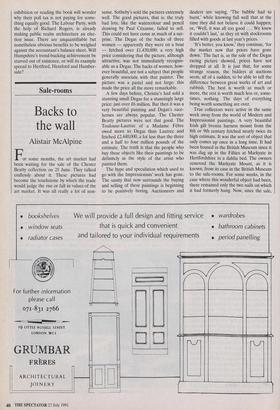Sale-rooms
Backs to the wall
Alistair McAlpine
For some months, the art market had been waiting for the sale of the Chester Beatty collection on 25 June. They talked endlessly about it. These pictures had become the touchstone by which the trade would judge the rise or fall in values of the art market. It was all really a lot of non-
sense. Sotheby's sold the pictures extremely well. The good pictures, that is: the truly bad lots, like the watercolour and pencil drawing by Paul Cezanne, failed to sell. This could not have come as much of a sur- prise. The Degas of the backs of three women — apparently they were on a boat — fetched over £1,430,000; a very high price considering that the picture, although attractive, was not immediately recognis- able as a Degas. The backs of women, how- ever beautiful, are not a subject that people generally associate with that painter. The picture was a pastel and not large: this made the price all the more remarkable.
A few days before, Christie's had sold a stunning small Degas for a stunningly large price: just over £6 million. But then it was a very beautiful painting and Degas's race- horses are always popular. The Chester Beatty pictures were not that good. The Toulouse-Lautrec of a Madame Febre owed more to Degas than Lautrec and fetched £2,440,000, a lot less than the three and a half to four million pounds of the estimate. The truth is that the people who buy these objects like their paintings to be definitely in the style of the artist who painted them.
The hype and speculation which used to go with the Impressionists' work has gone. The sanity that now surrounds the buying and selling of these paintings is beginning to be positively boring. Auctioneers and dealers are saying, 'The bubble had to burst,' while knowing full well that at the time they did not believe it could happen; or, 'Well, it was all too good . . . We knew it couldn't last,' as they sit with stockrooms filled with goods at last year's prices.
`It's better, you know,' they continue, 'for the market now that prices have gone down.' The fact is, as the sale of the Degas racing picture showed, prices have not dropped at all. It is just that, for some strange reason, the bidders at auctions seem, all of a sudden, to be able to tell the difference between great works of art and rubbish. The best is worth as much or more, the rest is worth much less or, some- times, nothing. The days of everything being worth something are over.
True collectors were active in the same week away from the world of Modern and Impressionist paintings. A very beautiful Irish gilt bronze harness mount from the 8th or 9th century fetched nearly twice its high estimate. It was the sort of object that only comes up once in a long time. It had been housed in the British Museum since it was dug up in the Fifties at Markyate in Hertfordshire in a dahlia bed. The owners removed the Markyate Mount, as it is known, from its case in the British Museum to the sale-rooms. For some weeks, in the case where this wonderful object had been, there remained only the two nails on which it had formerly hung. Now, since the sale, there is a notice which announces that the Markyate Mount has only been temporarily removed. I, for one, shall be glad if this means that it will soon be back there.
A painting which fetched good money recently was the William Hogarth of the Edwards Hamilton family on their terrace in Kensington. Mrs Edwards had the good sense to have herself painted reading a copy of The Spectator. This painting fetched £401,000: not as high a price as might have been hoped for in the balmy days of the art market's boom, but no dis- grace nevertheless.
Prices during the last few months in almost every department of the auction houses have been up and down, but there have been few bargains. The people who know this trade are still there to make cer- tain no work of any quality slips away. In Mount Street there is a well-known tailor, Douglas Hayward, who runs a comfortable testablishment. He was sitting one day hav- ing a cup of tea with a friend who buys his suits there, when his door was opened and a smartly dressed but small lady entered the shop.
`What price do you charge for suits?' she asked. He quoted his usual price. 'Does it matter what size you are?'
`No, all the same price, dear,' Douglas Hayward replied. 'It doesn't matter what size you are, large or small, all the same price.'
The lady left. 'She's probably married to a midget,' said Hayward to his friend. The woman returned a few minutes later with her husband: a man well over seven feet tall, with every part of his body in propor- tion. Selling suits, like selling paintings, is really a question of judging the market.



















































 Previous page
Previous page